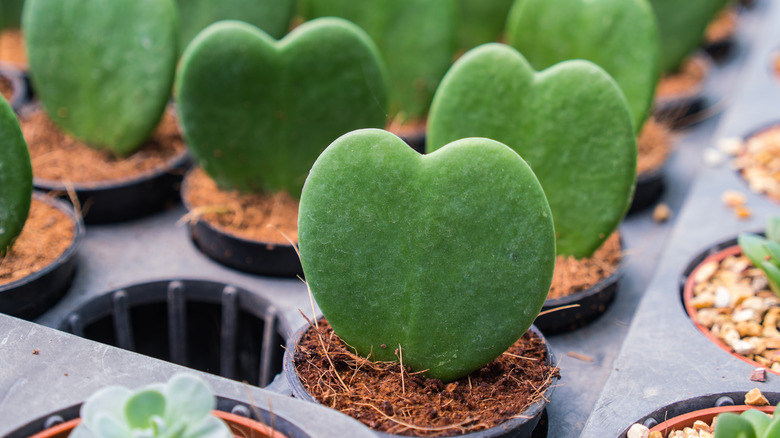The Heart-Shaped Plant Joanna Gaines Keeps In Her Living Room
According to Magnolia, you can now receive Joanna Gaines' favorite house plants shipped directly to your door! Among her list of favorite plants is the charming Sweetheart hoya, scientifically known as Hoya kerrii, adored for its unique heart-shaped leaves. Their lovely leaves not only symbolize affection but also reflect its ability to captivate indoor spaces with its charm, making it a beloved and visually appealing choice for houseplant enthusiasts. You'll catch Gaines' Sweetheart hoya sitting thoughtfully upon a stack of books by a window in her living room (via Instagram).
Native to Southeast Asia, this succulent vine belongs to the Apocynaceae family. Its defining feature is its fleshy, waxy leaves that grow in the shape of hearts, making it an endearing addition to indoor spaces. The Sweetheart hoya is highly favored as a houseplant due to its low-maintenance nature and distinctive appearance. Its thick leaves store moisture, allowing it to endure periods of drought, making it suitable for forgetful or novice plant owners. Its vining growth habit makes it versatile for hanging baskets or trailing down shelves, adding a touch of greenery to various settings across your home. Moreover, this plant produces clusters of star-shaped, fragrant flowers that resemble porcelain and exude a pleasant aroma. Its slow growth rate requires minimal pruning and upkeep, making it an ideal choice for busy individuals or those with limited gardening experience.
How to care for a Sweetheart hoya
While the Sweetheart hoya is renowned for being a low-maintenance succulent, it does have particular needs that should be met. Place your Sweetheart hoya in bright, indirect light. It can tolerate some morning or evening sun, but avoid exposing it to intense, direct sunlight, which can scorch its delicate leaves. According to Instagram, Joanna Gaines showcases her hoya on a table by a bright window.
Allow the top inch or so of the soil to dry out before watering. Water thoroughly and ensure the pot has proper drainage to prevent waterlogged roots, which can lead to rot. During the growing season — spring and summer — water more frequently, but reduce watering during the dormant periods. Sweetheart hoyas tolerate average indoor humidity levels, but they appreciate slightly higher humidity. You can mist the plant occasionally or surround it with other plants to create natural humidity. Maintain room temperatures between 60 to 80 degrees and protect the plant from sudden temperature fluctuations. Use a well-draining, succulent, or cactus mix for soil, and consider adding perlite to enhance drainage. During the active growing season, feed your Sweetheart hoya with a balanced, diluted liquid fertilizer every four to six weeks, but not during the dormant period. Repot your hoya every two to three years or when you notice it is becoming root-bound. Spring is the best time for repotting as it will have a chance to become established during its growing season.
How to propagate a Sweetheart hoya
One of the best features of the Sweetheart hoya is its easy propagation. There are two methods that work well for propagating this plant, and the first is by using a leaf cutting. Select a healthy leaf with a short stem attached to at least one node — the point from which roots will emerge. Allow the leaf cutting to dry for a day, encouraging the cut end to callus. This helps prevent rot. Plant the callused end of the leaf-cutting into a small pot filled with well-draining succulent or cactus soil. Place the pot in a warm, bright location with indirect light, and keep the soil lightly moist but not soggy. Roots will develop from the node, and eventually, a new shoot will emerge. Be patient, as this process can take several weeks to months.
The second method for propagating a Sweetheart hoya is by using a stem cutting. Choose a healthy stem with a few leaves attached and make a clean cut just below a node using a sharp, sterilized knife or scissors. Let the cut end dry and callus for a day or two, and then plant the cut end into a pot filled with well-draining soil, burying the node below the soil's surface. Place the pot in a warm, well-lit spot with indirect sunlight. Water the cutting sparingly, allowing the soil to dry slightly between waterings. Over time, roots will develop at the node, and new growth will emerge from the top.

